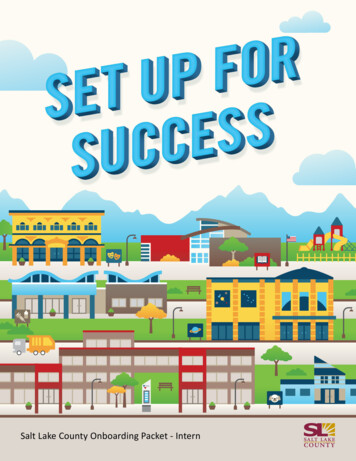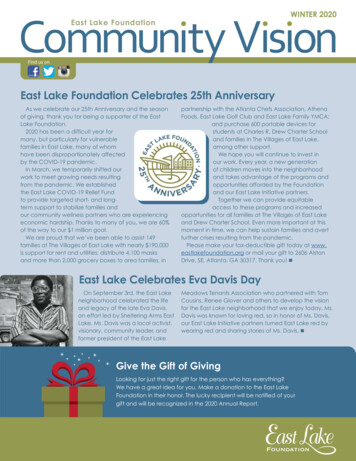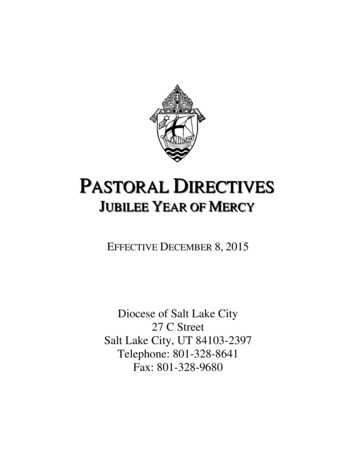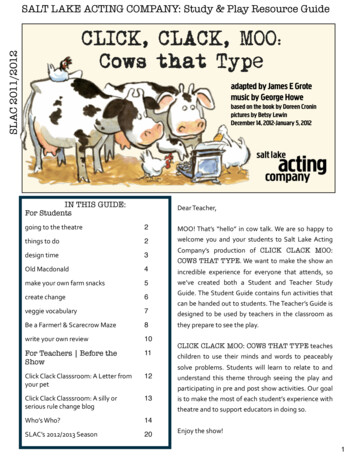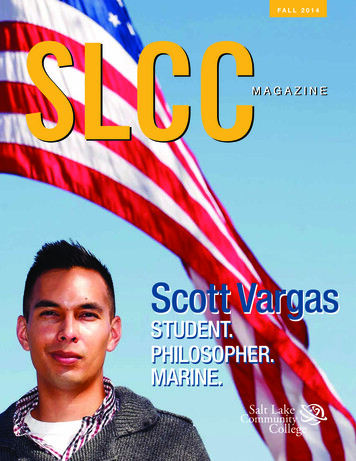
Transcription
FALL 2014Scott VargasSTUDENT.PHILOSOPHER.MARINE.
SLCC SceneGraduates dance in the aisle to the song “Happy” during the 2014 Commencement ceremony in West Valley City’s Maverik Center.SLCC Dance Company dancers perform the spring production of eMotion in theGrand Theatre at South City Campus.Salt Lake CommunityCollege received theAward of Excellenceduring the Utah LatinExpo held at the SaltPalace ConventionCenter.Retiring Athletics Director Norma Carr gets a hugduring a ceremony in her honor over the summer.
Former Bruins baseball players Tanner Banks, left, and Olympic medalist Eddie Alvarez were picked up by theChicago White Sox last summer.The SLCC Women’s Volleyball team readies for a fall photo shoot in the LAC.Art enthusiasts view the “Viva Frida” exhibit at the Center for Arts and Media.Student Justine Tabligan serves up “mocktails” duringthe annual year-end Bruin Bash at Taylorsville RedwoodCampus.WWW.SLCC.EDU1
A student celebrates his achievement during the 2014Commencement, with the largest ever graduating class at 4,218.Staff and students have fun at a summer barbecue at SouthCity Campus. Barbecues were held at the Jordan, TaylorsvilleRedwood and South City campuses.A little chalk art beautifies the first-ever Bearfoot Music Festival atSouth City Campus, featuring live music, games and a shoe drive.Participants in SLCC’s annual “Slick Science Camp” at the Taylorsville Redwood Campus make robots out of Legos and finish camp bylaunching bottle rockets using two-liter soda bottles, air and water and a trigger system that employs a student pulling a rope.2S CCGIFA L L 2014
DR. HUFTALINNAMED PRESIDENT OF SALT LAKE COMMUNITY COLLEGEFor more than two decades Utahnative Dr. Deneece Huftalinserved students, staff andfaculty at Salt Lake CommunityCollege before being named interimpresident of the college.When a national search was over to findthe eighth president of SLCC, The UtahBoard of Regents this past fall picked theschool’s beloved interim boss Huftalin tolead the college.“I am thrilled and honored to continueleading Salt Lake Community College,”said President Huftalin. “I will do mybest to ensure that SLCC remains aninclusive, student-centered institutionwhere individuals from diversebackgrounds can receive a high-quality,affordable education. I am eager toresume working with the trustees,faculty, administration, staff andstudents, and to continue our efforts tomake SLCC a premier comprehensivecommunity college.”A 21-member Presidential SearchCommittee narrowed the list down froman applicant pool of 55 to the threefinalists announced after conducting anextensive nationwide search. Regentsunanimously voted in favor of choosingDr. Huftalin during a public meeting atSLCC’s Taylorsville Redwood Campus,where she was introduced to anapplauding crowd as the school’s newestpresident.“President Huftalin is well knownwithin the college community andoutside of SLCC as very approachableyet someone with a well-honed intellectwho is dedicated, energetic, loyal andvigorously devoted to the students here,”said SLCC Public Relations DirectorJoy Tlou. “Dr. Huftalin’s appointmentto the top post here has been verywell received.”program at the University of Utah andserves on the Board of Directors forthe National Association of StudentPersonnel Administrators (NASPA)and YWCA Utah. Huftalin earned abachelor’s degree from the University ofUtah, a master’s degree from UCLA anda doctorate in Education, Leadershipand Policy from the University of Utah.“With a large and diverse studentpopulation spread over multiplelocations, the needs of this institutionare complex and require a strong leaderto be President,” said Dan Campbell,Chair of the Board of Regents. “I believeSince January 2014, Dr. Huftalin hadPresident Huftalin is that strong leader,served as the interim president of SLCC.and she will continue to positively shapeSLCC, and the Salt Lake regionDr. Huftalin’s appointmentas a result, for many yearsto come.”to the top post here hasbeen very well received.”She has served the SLCC students,faculty and staff for more than twodecades. Prior to joining SLCC, Huftalinheld positions at William Rainey HarperCollege, Northwestern University, theUniversity of Utah and the Institute forShipboard Education. Huftalin teachesin the Education, Leadership and Policy“I believe President Huftalinis the right president for SaltLake Community College, andher significant experience and strongcommitment to students will be a greatbenefit to SLCC and the Utah Systemof Higher Education,” added DaveBuhler, Utah Commissioner of HigherEducation.WWW.SLCC.EDU3
CONTENTSFALL 201412ON THE COVERPage 18: SCOTT VARGAS22TA B L E O F C O N T E N T S243Dr. Huftalin Named President ofSalt Lake Community College17 College Seeks to Expand C.T. E.Offerings at Westpointe Center6Helping Hungry Students8Science, Math and EngineeringSymposium18 Scott Vargas: Student. Philosopher.Marine22 Herriman Project House10 Animation: Sisters Combine Skills,Talent24 SLCC Student Annual Fashion Show28 Bridge Helps Horizonte Students Feel“I do Belong Here”12 Lights, Camera, Action: SLCC FilmSchool3232 Sekou Andrews: NationalPoetry Slam Winner16 The “N” Word Deconstructed inDiscussion36 2014 CommencementSLCC BOARD OF TRUSTEESGAIL MILLER,CHAIR4S CCSTANLEY B. PARRISH,VICE CHAIRGISANCHAITADATTAFA L L 2014CLINT W.ENSIGNASHOKJOSHIDAVID W.LANGPATRICIARICHARDSRICHARD R.TRANTERCarlos Moreno,STUDENT BODYPRESIDENTANNIE V.SCHWEMMER,ALUMNI PRESIDENT
LETTER FROM THE PRESIDENTSLCC Magazine was designed andlaunched to help showcase a few ofthe fantastic programs, happeningsand people here at Salt LakeCommunity College.In this, the fall 2014 edition, we getto meet an impressive young manby the name of Scott Vargas in ourcover story “Student. Philosopher.Marine.” I personally met withScott and a few of his professorsearlier this year for an interesting,lively and insightful conversationthat covered philosophy, thehuman condition and Scott’sown take on life, all of which isreflected in the article.BOARD OF TRUSTEESGail Miller, ChairStanley B. Parrish, ice ChairSanchaita DattaClint W. EnsignAshok Joshi, PhDDavid W. LangPatricia RichardsRichard R. TranterCarlos Moreno, Student ody PresidentAnnie V. Schwemmer, S CC lumni ssociation PresidentSLCC EXECUTIVE CABINETDeneece G. Huftalin, PhDPresidentClifton Sanders, PhDInterim Provost of cademic ffairsNancy Singer, PhDInterim ice President of Student ServicesDennis R. Klausice President of usiness ServicesAlison McFarlaneice President of Institutional dvancementTim Sheehanice President of Government and Community elationshe S CC aga ine is published by the Institutionalarketing and Communications epartment of Salt akeCommunity College. ll rights reserved. o part of thematerial printed may be reproduced or used in any formor by any means, electronic or mechanical, includingphotocopying, recording or by an information storageretrieval system without permission of the publisher.Salt ake Community College is an equal opportunityinstitution providing education and employment opportunitieswithout regard to race, color, gender, sexual orientation,religion, national origin, disability,age and or veteran status.You will also find an article about another lively conversation sponsoredby the SLCC Black Student Union in “The ‘N’ Word,”. The article sharesan example of the power of language and demonstrates the breadth ofdiscourse and debate alive at SLCC.At another event captured in this edition, words were not needed simplyyour eye to witness the level of skill, talent and creativity seen by hundredsat the SLCC Fashion Institute’s annual Raw Couture show. The story andimages in this edition take you back to the runway for a glimpse of theprofessionalism and high fashion created by our students.And finally, you will read several articles heralding the phenomenalprograms ramping up at our amazing Center for Arts and Media. Take atour of the facility through these pages and make a mental note to comevisit in person. Industry and community leaders as well as studentscontinually share comments about how lucky they are to learn and meetin such a state of the art facility. Even Sundance is in awe, as the GrandTheatre becomes a partner in the 2015 Sundance Film Festival- we’ll readand see more about that in the spring edition of SLCC Magazine.I hope you enjoy your glimpse into what SLCC has been up to lately. Moreimportantly, I thank you for your support of and interest in the College.Most Sincerely,Comments are welcome and should be sent via email toinstitutionalmarketing@slcc.edu or via S Post toSLCC MagazineSalt ake Community CollegeInstitutional arketing andCommunications,GP.O. oxSalt ake City, tah-Deneece G. Huftalin, PhDPresidentby Salt ake Community CollegeWWW.SLCC.EDU5
SLCC NEWSHelping Hungry StudentsCollege, Utah Food Bank team up for new pantryWhen Rose Gomez quit her jobgrooming pets to attend collegefull time, she thought she couldget by with moving back home – and itnever occurred to her that something asbasic as feeding herself would becomea problem.Gomez, 26, a Salt Lake CommunityCollege student who someday wantsto be a social worker, soon found thatshe needed help. And that’s whenshe discovered the Bruin CampusCupboard, which serves students andtheir families at SLCC’s South CityCampus in Salt Lake City.with about 10 percent returning asregular customers.SLCC social work student JustinHughes was there from the beginning,noting it took almost two years ofsurveying, planning and generatingsupport from the college before thepantry was able to open its doors.In the summer, the pantry is openMonday, Tuesday and Thursday fromnoon till 4 p.m. During the regularacademic year, the schedule changesto include longer hours. It first openedin fall 2013, and as of this past summerthe pantry had 125 registered clients,6S CCGIFA L L 2014“It’s been a great partnership so far,”said Walter May, programs managerat the Food Bank. “We’ve reallyenjoyed it.”Campus Cupboard volunteers pick upFood Bank donations once a month,using a forklift to load an SLCC boxtruck. May said SLCC is the first collegeto work with the Food Bank, whichhas over 130 partners helping to feedthe hungry throughout all of Utah’s 29counties. If SLCC wants to expandto offer perishable items or to opena second pantry at the TaylorsvilleRedwood Campus, May said the FoodBank is ready to help.“I decided one day to come up hereand see what it was all about,” saidGomez, who now runs the same smallfood pantry. “I’ve been helped so muchby it.”Like dozens of others that the pantryhelps each week, Gomez registeredfor the program, which allows itsparticipants to fill two reusable grocerybags with non-perishable food itemsonce a month. Everything fromuncooked black beans, cereal, tunaand salad dressing to cookies, snacks,flour and a variety of canned fruits andvegetables, it’s all at the pantry, locatedon the second floor at South City.The Campus Cupboard is a registered501c3 nonprofit, a designation itneeded in order to partner with the UtahFood Bank.Food donations to keep it stocked havecome from the Utah Food Bank, theBountiful Food Bank, outside donationsand food drives. But the toughest partabout running the pantry, Gomez added,is finding volunteers to staff it.“We’re doing everything we can toadvertise, to get the word out thatthere’s a food pantry for students,”Hughes said.Registration at the pantry only requiresproviding basic information and answersto a few questions.“Most people only use it when theyreally need it,” Gomez said. “Mostpeople don’t take advantage of it.”She said all types of people use thepantry as it continues to serve more andmore people – hundreds since it openedand expanded its hours – from all walksof life.“They look like everybody else,” Gomezsaid about the pantry’s clients. “Oneman recently said he was homeless,but to look at him you would not haveguessed that.”The SLCC Social Work Club received
the 2013-2014 “Best Club ServiceProject” award from the SLCC StudentAssociation for its work in opening andmaintaining the Campus Cupboard.“What they have accomplished in ayear’s time is amazing,” said EnriqueValasquez, associate professor in theSLCC Social Work program and advisorto the club. “I don’t know that mostfaculty and staff know the need of someof our students.”Valasquez said he had a student whoquit coming to class after she lost herjob and was forced to live out of her car.That student, he noted, benefitted fromthe pantry.“This is really grassroots social work,”he said. “I think the College shouldbe proud of the Social Work Club forbeing at the front line of programs thatare facilitating the educational processof some of the students who are inneed. We’re a community college, andwe’re supposed to be grounded in andinvolved in our community. There is nobetter program than this at this point.”Gomez doesn’t wax emotional abouthelping people who are in the sameposition as she once was. She knowsfirst hand that it’s not cheap to bea college student, let alone a fulltime student, and that many of hercolleagues, who don’t make muchmoney or have other means, might justneed a little help from time to time.“I kind of normalize it,” she said. “I knowthat it’s hard. If I think they feel awkwardabout it, I’ll help them through it. I feellike this is good for students, and beinga student is kind of pricey.”Trucking students, Utah Food Bank partner on deliveriesIn 2013, the Utah Food Bankdelivered over 36 million pounds offood – the equivalent of 28.4 millionmeals – to 130 partner agenciesthroughout Utah. It wasn’t easy.“It’s very expensive. It’s very timeconsuming,” said Ginette Bott, chiefdevelopment officer for the Utah FoodBank. “But it’s part of who we are.”Also last year students in the sixweek truck-driving program offeredat Salt Lake Community College weretraveling the same routes as driversfor the 33 vehicles in the Utah FoodBank fleet. But the SLCC drivers werehauling empty trailers.Talks in 2012 about teaming up turnedinto a partnership last year, and bylate May 2014 SLCC students hadhauled more than 20 loads for theUtah Food Bank to sites in Tremonton,Spanish Fork and Ogden.is really what I think is an incrediblepartnership,” Bott said.Students like Charles Atuahne saidthe experience of driving for theUtah Food Bank has allowed him tovolunteer for a worthy cause and getreal-world experience.“I think it gives the students morehands-on training in terms of drivinglong distances,” said Atuahne. “Thatkind of first-hand experience isgood for the students. It’s a win-winscenario.”SLCC truck driving instructor BillTovar said his students, with UtahFood Bank’s help, are getting onto shipping and receiving docks tocheck loads and look at manifestsand bills of lading.“You don’t get that anywhere else,”Tovar said. “There’s nobody else thatdoes what we’re doing now.”“What we’ve been able to see in 2014WWW.SLCC.EDU7
SLCC EVENTSIons, Rube Goldberg, NASA covered at theScience, Math and Engineering SymposiumSteve Evans, Thomas Clark, andTrevor Pratt looked ready forwork – neatly cropped hair,slacks, shirts with collars,and neckties.particles enter the space between thetwo grids and there is a resulting changein voltage, they immediately acceleratethrough the grid at a rate of about 30-50kilometers per second.They stood in front of a large posterboard bearing the title, “Ion Drives inApplication.” Suffice it to say these guysknew their stuff as they explained theirresearch during the 2014 School ofScience, Mathematics and EngineeringSymposium.In short, it’s a type of engine that givesone heck of a boost to whatever object itis attached to.“The application of using ion engines as atugboat to go to Mars is possible,” Evansexplained. When asking the three menwho would like to go to Mars someday,Clark piped in, “Dibs!”At the risk of butchering Pratt’sexplanation, an ion drive is an enginethat works by ionizing noble, orelectrically neutral, gases like xenon andargon, which are attracted to two grids atthe end of an engine. When the ionized8S CCGIFA L L 2014You’re probably wondering what guyslike these, who as of the symposiumin April, were pursuing their Associateof Pre-Engineering degrees, want todo in life.“I really like doing cool things,” Evanssaid. Trying to break it down for thelay person, he said he’d like to buildsomething useful or “sexy,” in termsof marketability, in the world ofhigh-tech gadgetry.Clark was a little more vague in hisanswer, which was to design something“cutting edge,” maybe along the lines
SLCC SUCCESSof aerodynamics. But it might be Pratt people want tokeep an eye on. “I want to save the world,” he said. And hewas serious.Pratt is interested in aerospace defense and maybe inventingan energy shield that can keep nuclear missiles from enteringU.S. airspace.These are the type of students that symposium guest speakerPaul Karner hopes will take his place someday. Karneris currently the senior program manager over avionicsand control systems for Utah-based ATK, specializing inaerospace and defense technologies.Karner gave a stern warning about the direction this countryis headed with relationship to the subjects of math, scienceand engineering.“It’s not easy. For some it comes easier, for others it takes alot of work,” he said. “It’s a road that is becoming less andless traveled by our younger folks. Any country that leads inscience, engineering and technology is what leads the world.I don’t mean in a militaristic sense, I mean that in a peacefulsense. We as a nation just simply are not producing enoughscientists and engineers right now. We’re in a significantdeficit.”Throughout the all-day symposium students and faculty gavepresentations and listened to lectures.Perhaps the most interactive poster of the day was presentedby a group of students in SLCC’s Fitness Technician Program,under the direction during the symposium of instructorChad Harbaugh.Clad in T-shirts, sweatpants and Lycra, this energetic groupof students put willing observers through several tests thatmeasure or determine an athlete’s susceptibility to injury.The name of their poster was, “Determining a More ReliableAthlete: Functional Movement Screening.”Through the use of very specific, simple yet demandingmovements, these fitness and physiology gurus-in-themaking were actually able to identify several athletes onSLCC’s own baseball and softball teams who needed to checkin with their doctors, trainers or physical therapists, perhapssaving them from future injury.“There’s lots of personal trainers out there who don’t knowwhat they’re doing,” explained group participant ArthurHockwald. “You walk into a gym and see what they’re doingand you cringe.”Former SLCC Globe sportseditor in NY TimesGerald Narciso grew up readingSports Illustrated, Time and People,gravitating toward features andhuman-interest stories.Even in college, however, Narciso,33, didn’t imagine he’d one daywrite stories that would appear inthe New York Times, Los Angeles Times and dozens ofother newspapers, magazines and websites.Narciso was born in Calgary, Canada, and at age 8his family moved to Salt Lake City. He graduatedfrom Judge Memorial Catholic High School.In 2003 he earned a degree in marketing fromWestminster College.Without any solid job prospects, he enrolled thefollowing year in Salt Lake Community Collegeto study graphic design. “I thought it would be agood complement to my marketing degree fromWestminster College,” he said.Narciso started freelance writing while at SLCC,stringing for the Salt Lake Tribune as a high schoolbasketball reporter. He also contributed to UtahSports Magazine, Utahjazz.com and to the Arts andEntertainment and opinion sections of SLCC’s TheGlobe newspaper.Narciso graduated in 2006 from SLCC with anAssociate degree in communication and an emphasison print journalism. He was the sports editor at TheGlobe during his final year at SLCC.“I had one of my favorite teachers and mentorsI’ve ever had with (SLCC instructor) Nick Burns,”Narciso said.From there, initiative, skill and talent took over ashe moved to Vancouver to work as a sports writer forKidzworld.com and for the NBA publication DimeMagazine, which eventually brought him on full timeand all the way to New York City in 2009.That same year he began contributing to the New YorkTimes, in which he estimates he had been publishedabout 15 times as of last spring. But with the rapidlychanging and daunting face of print journalismin recent years, Narciso went in search of a safercareer path.By 2010, he was working as a media relationscoordinator for British Columbia Institute ofTechnology in Vancouver. In February 2013 he tooka job as a “brand journalist” for the global companyAvigilon, which makes HD video surveillance products.“Now I work in content marketing, which is a trendfor a lot of journalists nowadays,” Narciso said. “Itallows me to stay creative, write and edit. It is kindof a good mix between my marketing and journalismbackgrounds.”WWW.SLCC.EDU9
S L C C A N I M AT I O NSisters combine skills, talentsBrenda Gaytan and her sisterli abeth are two of three childrenraised by exican immigrants.hey grew up poor in aylorsville,living in the top half of a duplex withtheir aunt below. It was that aunt whopurchased the family’s first computer froma yard sale, despite no adults in the duplexknowing how to use it.Yet both of them gravitated toward aninterest in Salt ake Community College’sanimation program, which requires anadvanced knowledge of specific computersoftware.ost animation students, accordingto associate professor Chad rikson,are those with an artistic background,with some drawing and technical skills,a familiarity with computers and thepatience to create and collaborate.“ he most successful students will bethe ones who are the most collaborative,”rikson said. nimation students atS CC are typically those either seekinga vocational degree or a transferabledegree for a four-year institution. “I don’tknow any of them who are here just forfun,” said rikson. “It’s a time-intensive,laborious process. fter the fun wears off,we lose those students.” nd the studentssticking around, he added, are those who10S CCGIFA L L 2014want to work in the industry, one in whichjobs aren’t always plentiful and where thework usually means toiling in a cubicle,lots of meetings and always having adeadline looming.at an early age. “I sat there for hours justtyping everything I could think of,” shesaid. he fascination never waned, andnow everyone in the family comes to herfor help with computers. self-described“forever” student who loves learning,“It’s a very nomadic type of job,” saidrenda started out in college interestedrikson, who for the past six years atina teaching career, drifting into design,S CC has enjoyed the stability of amulti media and finally animation. “I foundteaching career in animation. eforeout I just really, really liked it,” said renda.teaching he had been laid off three times.s she earned money at jobs while going“You get a lot of studio flare-ups, and thento school, renda nurtured her sisterthey’ll collapse.” So, what type of personli abeth’s interest in art by purchasingcolored pencils and art“I loved it. It was hard to learn, supplies for her.but it was something that Iactually wanted to sit throughand find out how it worked.And I did pretty well.”stays with animation “It’s those whowant to do it enough to weather that typeof job situation,” he added. “It’s fun, butit’s work.”ith their sights set on ssociate ofpplied Science degrees in animation,the Gaytan sisters are the first in theirfamily to earn college degrees. Gettingthe family computer to work at theirduplex in aylorsville fascinated renda“I’ve always lovedart, since I was inelementary school,”said li abeth. “Istarted out with stickfigure comics andslowly moved on fromthere. It’s something I really like. ut I wastold that visual art isn’t a real job, thatyou’re not going to get any job drawing.”In high school she took an engineeringclass because she liked the problemsolving aspects of it. “ ut the math wastoo hard, and the physics was too hard forme to do,” li abeth said. “ hat’s whenit stopped being fun, when I couldn’tunderstand it.”
Still searching for academic direction,she heard about a - animation coursebeing offered at Granite echnicalInstitute on State Street in Salt akeCity. “I loved it,” she said. “It was hard tolearn, but it was something that I actuallywanted to sit through and find out how itworked. nd I did pretty well.” ext stop,college with her sister renda.“ nd it’s beautiful.” nimation graduatesfrom S CC or from four-year institutionscan end up working in video games, filmor , and the work varies depending ona student’s focus during school. “ e tryto get them to speciali e,” rikson said.“You’re not going to find a job listing thatsays, e want someone who does stuff.’”nd that’s where the sisters Gaytan takecollaborating as far as they can.renda is a driven person, idealistic inthe face of a reality about the animationindustry that might drive most peopleway. ven the animation instructor is upfront about how hard it can be to land orkeep a job in animation.“ he biggest thing you have to thinkabout is if it’s your passion and if you’regoing to be working toward it,” rendacountered. “ hat’s what is going toseparate you from the rest. If you lookat two portfolios, it’s pretty easy to seewhich one is passionate and which onedoes it for fun. aving some passion reallyseparates you from the rest.”She has heard that the job market in tahis comparatively robust, with one of thebiggest gaming “hubs” in the country thatincludes big names like isney andlectronic rts Games, who are lookingfor the type of skills renda and li abethare acquiring at S CC.nimation students at the College learnthe old-school drawing techniques in whatrikson called the “roots” room, whileacross the hall they use the latest softwareand technology, such as the industrystandard interactive pen displays knownas Cintiq , to work out animation projectson the computer.he Gaytans love it that the entireanimation program is now under one roofat the new Center for rts and edia atSouth City Campus on State Street in Saltake City. li abeth recalled how someclasses were at South City and otherswere at the main aylorsville edwoodCampus. “ nd now it’s all here,” she said.renda’s expertise is on the technicalside with more classes under her belt,while li abeth’s strength lies more on theartistic side. ogether they’re now tryingto steer their -year-old brother, whoseinterest is mostly in playing video games,not in the animation behind them.“ e’re trying to mold him to be anaudio editor, because we hate workingwith audio,” renda said. “ e’re veryvisual, but when it comes to audio we’rehorrible.” or now, the sisters have eachother.“ e’re able to work very well witheach other,” enda said, admitting it didn’talways used to be that way. “ e kindof grew up. I think working together, wereally shine.”WWW.SLCC.EDU11
SLCC FILMLIGHTS, CAMERA, ACTION!SLCC FILM SCHOOL CUTTING EDGE12S CCGIFA L L 2014
Channing Lowe crawls througha window from an equipmentroom, where he has just selecteditems that will help him teach his filmstudents about lighting a scene hereoutside the Center for Arts and Mediaat Salt Lake Community College’sSouth City Campus.Lowe is light-hearted, loose and veryinvolved during his film class, even ifit means using a window instead ofa door to speed things along.Everyone in a Monday-morningclass moves outside to a plaza andbegins setting up, fastening metalbars together that will hold huge lightreflectors and tweaking a camera’scontrols before capturing a fewshort clips that they’ll look at later inthe classroom.“Now we need some gaffing tape,”Lowe shouts into the group ofstudents. “Roll video,” he says a shorttime later.The whole scene has the look and feelof a real movie setting. And that’s theidea for his film students, who hopeone day to be working in the industry.WWW.SLCC.EDU13
HU M B L E B EG I N N I N G SThe 2013-2014 academic year markedLowe’s seventh year at the College. Hestarted teaching in the film programwhen it was still in its infancy. “Weused to have these rinky-dink lightkits,” Lowe recalled.They had a few cameras, tripods andcomputers. “And that was really it,” headded. There was a classroom, and aconverted automotive garage was thesound stage or, as Lowe remembers,more like an “echo chamber.”Lowe, who outside the classroomhas worked at the local Fox televisioncapabilities and enough chains tohoist literally tons of set materialsand lighting.No one sits still in the sound stage,where creative minds collectand collaborate and come alivelike you don’t see students do inmost classrooms.QUIET ON THE SETCatherine Mortimer is the first to gether hands on the Canon camera theclass will be using to shoot just outsideof the Center for Arts and Media on acloudy Monday.Mortimer. “I love every aspect of it.I really like being part of the wholeprocess. It’s like a giant puzzle ofputting everything together. I think it’sa control thing, maybe,” she laughed.If she wasn’t hooked before, theCenter for Arts and Media hascompelled Mortimer to stick with it.“When I heard about this program,it’s one of the big reasons I said, ‘I’mgoing to go ahead and do this,’” shesaid. “All of this equipment is amazing.That’s why I want to hurry and makeprojects while I have access to thisequipment.”Mortimer and her colleagues haveaccess to lights that run the gamutall the way to 5,000 watts, myriadprofessional-grade set materialsand equipment and the same kind ofRed brand cameras that are used byleading filmmakers to shoot movieslike the recent “Robocop,” “300:Rise of an Empire,” “Ender’s Game,”“Captain America: The Winter Soldier”and “The Hobbit.”She also likes that the instructors areexperienced in the industry, workingin the same jobs that they’re talkingabout in class. Combined, instructorsLowe
Salt ake Community College Institutional arketing and Communications, G P.O. ox Salt ake City, tah - by Salt ake Community College SLCC Magazine was designed and launched to help showcase a few of the fantastic programs, happenings and people here at Salt Lake Community College. In this, the fall 2014 edition, we get to meet an impressive young man



